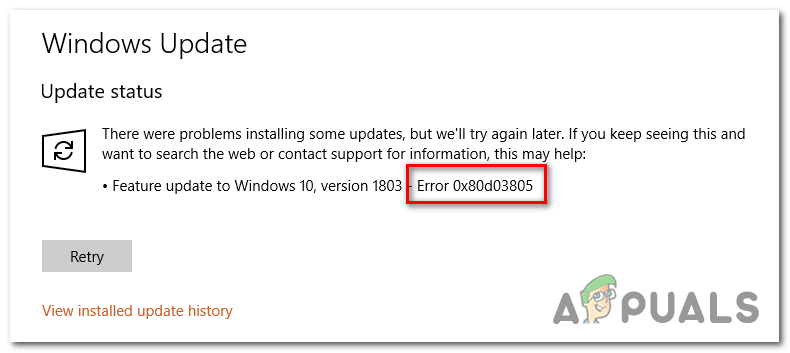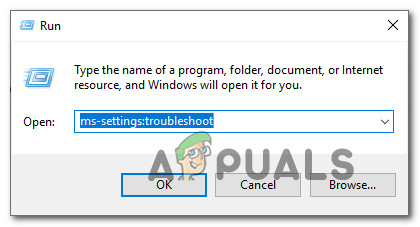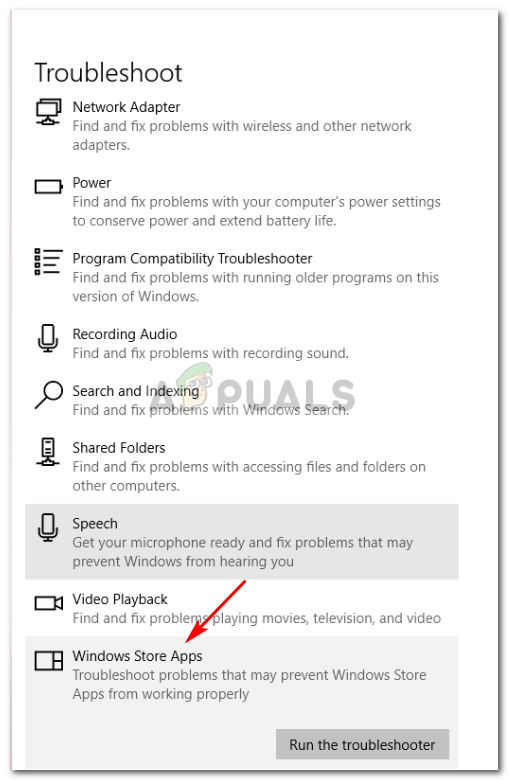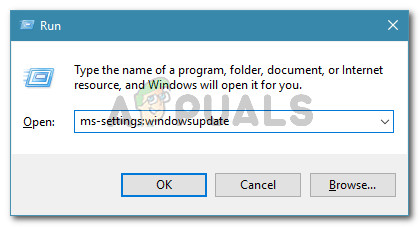Method 1: Running the Windows Store Troubleshooter
Before we move on to other potential repair strategies, we should start by seeing if your Windows installation is not equipped to resolve the issue automatically. If the 0x80D03805 error code is caused by a common inconsistency that Microsoft is already aware of, you will be able to resolve it easily simply by running the Windows Store Troubleshooter. The Windows Store Troubleshooter utility contains a selection of automated repair strategies that can be automatically deployed if the initial analysis manages to identify an issue that’s already covered. If the 0x80D03805 error code is already covered by a repair strategy, then the procedure below should end up resolving the issue entirely. Several affected users have confirmed that the error was resolved after deploying the Windows Store Troubleshooter. Here’s what you need to do: If you’re still seeing the 0x80D03805 error code when you try to initiate a download with Windows Store, move down to the next method below.
Method 2: Update Windows to the latest version
As it turns out, there is one security update (Security Update for Microsoft Windows KB4462919) that is likely to cause this kind of behavior. This update was released at the end of 2018 and is known to cause the 0x80D03805 error code when performing certain actions in Microsoft Store. Fortunately, Microsoft has since released a hotfix for this issue. Since December 2018, you can resolve this problem (if it’s occurring due to a bad update) by installing every pending Windows 10 update. This will ensure that the hotfix for the issue will automatically get installed. Here’s a quick guide on installing every pending update on your Windows 10 computer: If the problem persists, start following the next potential fix below.
Method 3: Clearing the cache of Windows Store
According to several different affected users, this problem can also occur due to some temporary files that will ultimately inhibit your PC’s ability to establish connections between the integrated UWP (Universal Windows Platform) store and the relevant Microsoft services. In most cases, the problem will turn out to be caused by a selection of temp files that are stored inside the cache folder. As it turns out, this type of problem will most likely appear after a security scanner quarantined some items belonging to the Store cache or after an unexpected machine interruption. If this particular scenario is applicable, you should be able to resolve the issue by resetting the entire Windows Store cache. In this case, there are two different approaches that will get you there on Windows 10. Option 1 is easier, but it involves running a series of commands from an elevated CMD prompt. Option 2 is more tedious, but it will allow you to do it all from the Windows settings menus. Feel free to follow whichever method you feel more comfortable with:
Resetting the Windows Store cache via an elevated CMD
Resetting the Windows Store via Settings app
If you’re still encountering the 0x80D03805 error when you try to initiate the download of an app or game through the Windows Store component, move down to the next method below.
Method 4: Re-registering DLLs used by Windows Store
As it’s been confirmed by several affected users, another possible reason why the 0x80D03805 error might occur is due to one or more DLL (Dynamic Link Library) files that are no longer registered correctly. This is quite rare on Windows 10 but it’s still possible under certain circumstances (typically after a cleaned virus infection). If this scenario is applicable in your case, you should be able to fix the problem by re-registering all DDLs that are working together with the Windows Store component. Here’s how to do this:
Method 5: Refresh every OS component
If none of the methods that you followed above have allowed you to fix the issue, there’s a high chance that you see the 0x80D03805 error due to an underlying corruption issue that cannot be resolved conventionally. In a situation such as this one, the most efficient way of taking care of the issue is to refresh every OS component along with any booting-related data. When it comes to achieving this, you can do this either by a clean install or by performing a repair install (in-place repair) operation. A clean install is the easiest solution out of the bunch – It doesn’t require you to provide an installation media and it can be initiated with just a few simple clicks. But the major disadvantage is that you won’t be allowed to keep any of your data unless you back them up in advance. A more efficient approach is to go for a repair install (in-place repair). Although this process is long and will require you to use an installation media, it will ultimately allow you to keep all your files (personal media, games, applications, user preferences) without having to back the data up.
Microsoft Finally Rolls Out Redesigned Photos App To Insiders and Releases…Fix: Error 0x8013153B when opening Microsoft StoreHow to Fix Microsoft Store Error Code 0x80070520How to Fix Microsoft Store Error 0x80131505 on Windows 10?







